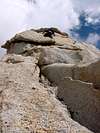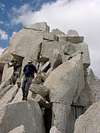|
|
Route |
|---|---|
|
|
37.14000°N / 118.648°W |
|
|
Scrambling |
|
|
Spring, Summer, Fall |
|
|
Most of a day |
|
|
Class 4 |
|
|
III |
|
|
Approach
The South Ridge is the technically easiest route to the base of Clyde Spires, no more than class 3, and much of it class 2. It can be most easily reached from the south in the vicinity of the Pacific Crest Trail below Helen Lake, but the closest trailhead involves an approach from the north and over Echo Col, the route described here.The Lake Sabrina TH is located just east of the lake's outlet. There is parking for about 6-7 cars in three small lots near the trailhead. Overnight parking is a quarter mile down the road at the fork with the road to North Lake. Follow the trail to Blue Lake, Dingleberry Lake and then Sailor Lake for about 7 miles. Just past Sailor Lake and before reaching Hungry Packer Lake, leave the trail heading southeast to the west shore of Moonlight Lake, then south following the drainage to Echo Lakes. Clyde Spires towers above you to the southwest, the two gray towers on the right (further right is the redish brown, and higher Crumbly Spire).
From Echo Lake's outlet, follow around the east side of the lake, traversing upwards through a cliff band (and a good amount of snow most likely, depending on season) to the cirque and small glacier in a bowl south of Echo Lakes. Cross the bowl heading southwest, aiming for the U-shaped notch on the right side known as Echo Col. The rock is class 3 leading up to Echo Col, class 2 on the southwest side. Except in early season, you can leave your snow gear at the col for your return.
Descend Echo Col for about 50 feet until you can begin traversing west across the bowl between the col and the South Ridge (class 2). Dropping down before climbing to the ridge may be less tedious than the traverse, depending on your preference.
Route Description
The South Ridge itself is mostly class 2, gains about 500ft, and for the most part not terribly exciting. Most of this section will be devoted to the summit spires which are the most interesting aspects of this route.Once on the South Ridge, follow the ridge more or less straight up. The climbing difficulty will increase to class 3 in the upper part, and class 4-5 if you stay more directly on the ridge. The ridge leads directly to the East Spire.
East Spire
The East Spire is an impressive mass of granite and a fine summit, but hardly what can be termed a spire. It has more of a classic pyramid shape than anything remotely spire-shaped. There are at least three ways to climb the East Spire. The easiest is from the east, class 3. When climbing the South Ridge, stay to the right of the ridge near the summit and traverse around to the east side. A short knife-edge block is crossed and then large blocks to the summit. The first ascent party, led by Norman Clyde in 1933, climbed the East Spire from the west side, class 4. To reach the "classic" route, move to the left of the South Ridge as you near the top and climb to the notch just west of the East Spire. Secor describes this as a difficult slab climb, and at first it is indeed intimidating. A steep ramp angles up to the north with the wall on the far side overhanging. A small ledge cuts the slab horizontally and is the key to ascending this lower section. Cross the ledge from right to left and climb the ramp on the easier outside edge. Flakes and cracks (with good holds) are used to scramble up the near vertical west face to the summit. A third option is to climb the South Ridge (itself having two sub-options) directly. The easiest of these is to climb nearly to the start of the east side, then climb a convenient two foot wide ramp that angles left back to the South Ridge and within 30 feet of the summit. Climb flakes with good holds to the summit (class 3-4). One can also climb the South Ridge directly - bypass the sharpest blocks on the ridge before the summit just to the right and climb class 4 blocks and slabs along the rounded uppermost part of the ridge to the summit (you'll intersect the ramp route when 30-40 feet from the summit).
West Spire
The West Spire is a classic spire, a single monolith rising some 30ft nearly vertical with a flat top about 3' by 5'. Without a convenient lower block that provides class 4 access, the spire would probably be rated at 5.9 or higher. The lower block is separated from the main block by a foot-wide chimney and can be reached from at least two sides. The easier side is from the east where a short climb up the chimney is followed by a mantle to stand atop the lower block. The chimney can alo be climbed from the west side via a vertical 8-foot lieback and then climbing into the chimney and up to the lower block. The top of the summit block is about shoulder level when standing on the lower block. Be warned that some good scramblers have called it a day at this point. Rock shoes can certainly make the final mantle easier, but they aren't required. This is the only move on the West Spire that has any serious exposure.









